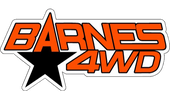Heim Joints 101
We get a lot of questions about Heim Joints, they are well warranted. There is a lot of information to know about the different options, and dimensions of heim Joints we carry here at Barnes4wd. So let’s start off with the most important question what is a heim joint?
I could give you a definition off the internet or out an automotive dictionary. Those kind of technical definitions have never really helped me. My definition is for those of us that are newbies to the 4wd world. Any of you veterans that can add input it’s definitely welcomed. A heim Joint is a Threaded rod with a circular top, with a moving ball bearing centered in the circular top.
Heim joints are used in a variety of applications. Suspension, heim joints can be used as the linkage of you upper and lower control arms. Steering, heims can be used on drag links, or tie rods. As far as vehicle applications anything that pivots or moves back and forth, a heim joints can be used So for those of us that are looking at parts for crawling, wheeling (both slang terms for driving off-road over obstacles), or building up our suspension. Heim joints are a great way to go.
Heim joints are helpful in precisely locating your wheels. The precise location of your wheels is a huge part of 4wd suspension. For example if you have one tire on the ground and another on a boulder, knowing where that tire is landing and how it’s going to move over that obstacle is a huge advantage! To be successful in clearing the obstacle and bragging to all your friends about how you just dominated it.
A lot of questions we get are about the dimensions of our heims. So let’s take for example our 7/8” x ¾” Heim Joint.
The 7/8 is the thread size of the threaded shank.
The ¾ is the diameter of the bore hole.

Now what do we do with this heim joint. What most of our customers do is put this into a tube insert that has been welded into a piece of D.O.M tubing (steel piece of pipe).
This bring me to another frequently asked question. What tube insert do I need? We can continue using this 7/8 x ¾ heim for our example.
Tube inserts can come in a variety of sizes as well. For this example we will need a 7/8 tube insert so that the diameter of our heim matches our tube insert. We offer a variety 7/8 tube inserts with different outer diameters. The outer diameters are different so that you can insert our tube inserts into different sizes of tubing. Confused yet?
Here is how we sell tube inserts and what all the numbers mean broken down.
TUBE INSERT (7/8-14) FOR 1 1/2" ID TUBE

7/8 -14 Thread Size of tube insert. (Not inner diameter of tubing.)
For 1 ½” Id Tube this means the tube that you can put this insert in needs to have an inner diameter of 1 ½” inches.

Now your 7/8” diameter heim will fit into your 7/8” tube insert, and your 7/8” tube insert with 1 ½” Outer diameter, Will fit into any tubing with 1 ½” inner diameter.

The tube insert will be welded into your pipe. The heim will then be screwed into the tube insert. A jam nut can be placed on the heim to prevent loosening before screwing it into the tube insert. Your finished product will look like this.

Hopefully this helps us understand Heim Joints a little better. In my next blog we will get into how to make heim joints move and grove with Misalignment spacers.

